Extracapsular Tonsillectomy versus Intracapsular Tonsillotomy in Paediatric Patients with OSAS
Abstract
1. Introduction
- ○
- OSAS clinical improvement after surgery;
- ○
- the possible presence of early and/or late haemorrhagic complications;
- ○
- postoperative pain monitoring.
2. Materials and Methods
2.1. Case Study
- I.
- Anamnesis
- II.
- Survey OSA-18 specific for SBD (obstructive sleep-disordered breathing)
- -
- A score below 60 implied a minor impact on the quality of life.
- -
- A score between 60 and 80 meant a moderate impact.
- -
- A score above 80 meant a major negative impact on the patient’s quality of life.
- -
- 1873 patients (37.46%) presented values < 60 (minor impact);
- -
- 2408 patients (48.16%) presented values between 60 and 80 (moderate impact);
- -
- 719 patients (14.38%) presented values between 80 and 105 (major impact).
- III.
- Upper respiratory tract endoscopy:
- -
- First-degree obstruction—adenoid volume limited to the nasopharynx roof;
- -
- Second-degree obstruction—adenoids reach the upper half of the nasopharynx;
- -
- Third-degree obstruction—adenoid volume covers ¾ of the nasopharynx space;
- -
- Fourth-degree obstruction—adenoids completely obstruct the nasopharynx.
- -
- 1st degree—intravelic tonsils, completely behind the front tonsillar pillar;
- -
- 2nd degree—lightly hypertrophic tonsils, barely protruding from the front tonsillar pillar;
- -
- 3rd degree—hypertrophic tonsils, occupying ¾ of the available space;
- -
- 4th degree—extremely hypertrophic tonsils, completely obstructing the aero-digestive tract (kissing tonsils).
- ○
- 1873 patients (37.46%) presented 1st–2nd degree adenotonsillar hypertrophy;
- ○
- 3127 patients (62.54%) presented 3rd–4th degree adenotonsillar hypertrophy.
- IV.
- Night pulse oximetry
- ○
- 3 desaturation clusters or at least 3 desaturations < 90% (during the night recording) (Category 2, minor OSAS);
- ○
- 4 desaturations < 85% (Category 3, moderate OSAS);
- ○
- 4 desaturations < 80% (Category 4, major OSAS).
- ○
- 1879 patients (60.09%) presented Category 3, moderate OSAS;
- ○
- 1248 patients (39.91%) presented Category 4, major OSAS.
2.2. Inclusion and Exclusion Criteria
- ➢
- Age between 3 and 12 years;
- ➢
- OSAS diagnosis following the indications in the addressing document for the security and pertinence of adenoidectomy and tonsillectomy surgeries, elaborated by the Italian Ministry of Health: [21]
- -
- medical history of respiratory sleep disorders;
- -
- 3rd–4th degree adenotonsillar hypertrophy;
- -
- positive dynamic night pulse oximetry (Category 3–4 following McGill Oximetry Scoring System);
- -
- OSA-18 survey with a result ≥ 60;
- ○
- 1st–2nd degree adenotonsillar hypertrophy;
- ○
- Cranio-facial anomalies;
- ○
- Neuromuscular pathologies;
- ○
- Obesity;
- ○
- Recurring adenotonsillar infections with over 2 episodes a year;
- ○
- Documented allergy history (through skin-prick test).
2.3. Preoperative Procedure
2.4. Surgery Type
2.5. Postoperative Results Evaluation
- I.
- The presence of possible postoperative complications, mainly represented by pain and perioperative bleeding;
- II.
- The degree of postoperative respiratory obstruction, comparing it with the preoperative value through pulse oximetry; carried out 6 months after surgery;
- III.
- Tonsillar hypertrophy relapse in Group A and/or the presence of residuals in Group B with clinical evaluation taking place 1 month, 6 months, and 1 year after surgery;
- IV.
- Postoperative quality of life assessed through providing the patient’s parents with the same survey provided before the surgery 1 month, 6 months, and 1 year after the surgery.
2.6. Data Analysis
3. Results
3.1. Surgery Comparative Analysis
- ●
- 1069 patients, Group A (equal to 34% of the children) underwent adenoidectomy and intracapsular tonsillotomy. Of these:
- -
- 172 patients were treated in 2014;
- -
- 180 patients were treated in 2015;
- -
- 203 patients were treated in 2016;
- -
- 249 patients were treated in 2017;
- -
- 265 patients were treated in 2018.
- ●
- 2058 patients, Group B (equal to 66% of the children) underwent adenoidectomy and extracapsular tonsillectomy. Of these:
- -
- 510 patients were treated in 2014;
- -
- 423 patients were treated in 2015;
- -
- 395 patients were treated in 2016;
- -
- 409 patients were treated in 2017;
- -
- 321 patients were treated in 2018.
3.2. Postoperative Morbidity
3.3. Results and Clinical-Instrumental Follow-Up of Group A Patients: Intracapsular Tonsillotomy
- ○
- 541 patients, OSA-18: score up to 50 (minor impact of the pathology on the quality of life) (51% of cases);
- ○
- 528 patients, OSA-18: score between 50 and 85 (moderate impact of the pathology on the quality of life) (49% of cases).
- ○
- 20 patients scored up to 60 (moderate impact of the pathology on the quality of life) (1.87% of the cases);
- ○
- 626 patients scored up to 40 (normal quality of life) (58.5% of the cases);
- ○
- 423 patients scored up to 30 (normal quality of life) (39.5% of the cases).
- ○
- 846 patients presented a score up to 30 (normal quality of life) (80.6% of the cases);
- ○
- 203 patients presented a score up to 18 (normal quality of life) (19.4% of the cases) (Figure 4).
3.4. Results and Clinical and Instrumental Follow-up of Group B patients: Extracapsular Tonsillectomy
- ○
- 1198 patients had a score up to 40 (normal quality of life) (58% of the cases);
- ○
- 860 patients had a score up to 60 (moderate pathology impact on the quality of life) (42% of the cases).
- ○
- 36 patients had a score up to 60 (moderate pathology impact on the quality of life) (1.75% of the cases);
- ○
- 1060 patients had a score up to 40 (normal quality of life) (51,5% of the cases);
- ○
- 962 patients had a score up to 30 (normal quality of life) (46.7% of the cases).
- ○
- 1456 patients had a score up to 18 (normal quality of life) (71% of the cases);
- ○
- 566 patients had a score up to 30 (normal quality of life) (27.5% of the cases) (Figure 6).
3.5. Cases of Postoperative Therapeutic Failure
4. Discussion
5. Conclusions
Author Contributions
Funding
Institutional Review Board Statement
Informed Consent Statement
Conflicts of Interest
References
- Kaditis, A.G.; Alvarez, M.L.A.; Boudewyns, A.; Alexopoulos, E.I.; Ersu, R.; Joosten, K.; Larramona, H.; Miano, S.; Narang, I.; Trang, H.; et al. Obstructive sleep disordered breathing in 2- to 18-year-old children: Diagnosis and management. Eur. Respir. J. 2015, 47, 69–94. [Google Scholar] [CrossRef] [PubMed]
- Marcus, C.L.; Brooks, L.J.; Ward, S.D.; Draper, K.A.; Gozal, D.; Halbower, A.C.; Jones, J.; Lehmann, C.; Schechter, M.S.; Sheldon, S.; et al. Diagnosis and management of childhood obstructive sleep apnea syndrome. Pediatrics 2012, 130, e714–e755. [Google Scholar] [CrossRef] [PubMed]
- van der Meulen, J. Tonsillectomy technique as a risk factor for postoperative haemorrhage—Nazional Prospective Tonsillectomy Audit (NPTA). Lancet 2004, 364, 697–702. [Google Scholar] [CrossRef]
- Wood, J.M.; Cho, M.; Carney, A.S. Role of subtotal tonsillectomy (‘tonsillotomy’) in children with sleep disordered breathing. J. Laryngol. Otol. 2013, 128 (Suppl. 1), S3–S7. [Google Scholar] [CrossRef] [PubMed]
- Koltai, P.J.; Solares, C.A.; Koempel, J.A.; Hirose, K.; Abelson, T.I.; Krakovitz, P.R.; Chan, J.; Xu, M.; Mascha, E.J. Intracapsular tonsillar reduction (partial tonsillectomy): Reviving a historical procedure for obstructivesleep disordered breathing in children. Otolaryngol. Head. Neck Surg. 2003, 129, 532–538. [Google Scholar] [CrossRef] [PubMed]
- Tunkel, D.E.; Hotchkiss, K.S.; Carson, K.A.; Sterni, L.M. Efficacy of powered intracapsular tonsillectomy and adenoidectomy. Laryngoscope 2008, 118, 1295–1302. [Google Scholar] [CrossRef]
- Ferrari, L.R.; Donlon, J.V. Metoclopramide reduces the incidence of vomiting after tonsillectomy in children. Anesth Analg. 1992, 75, 351–354. [Google Scholar] [CrossRef]
- Paradise, J.L. Tonsillectomy and adenoidectomy. In Pediatric Otolaryngology, 3rd ed.; Blueston, C.D., Stool, S.E., Kenna, M.A., Eds.; WB Saunders: Philadelphia, PA, USA, 1996; pp. 1054–1065. [Google Scholar]
- Vicini, C.; Eesa, M.; Hendawy, E.; Pari, M.; D’agostino, G.; AlGhamdi, S.; Meccariello, G. Powered intracapsular tonsillotomy vs. conventional extracapsular tonsillectomy for pediatric OSA: A retrospective study about efficacy, complications and quality of life. Int. J. Pediatr. Otorhinolaryngol. 2015, 79, 1106–1110. [Google Scholar] [CrossRef]
- Cantarella, G.; Viglione, S.; Forti, S.; Minetti, A.; Pignataro, L. Comparing postoperative quality of life in children after microdebrider intracapsular tonsillotomy and tonsillectomy. Auris Asus Larynx 2012, 39, 407–410. [Google Scholar] [CrossRef]
- Franco, R.A.; Rosenfeld, R.M.; Rao, M. Quality of Life for Children with Obstructive Sleep Apnea. Otolaryngol. Neck Surg. 2000, 123, 9–16. [Google Scholar] [CrossRef]
- Gorman, D.; Ogston, S.; Hussain, S.S.M. Improvement in symptoms of obstructive sleep apnea in children following tonsillectomy versus tonsillotomy: A systematic review and meta-analysis. Clin. Otolaryngol. 2017, 42, 275–282. [Google Scholar] [CrossRef] [PubMed]
- Ericsson, E.; Lundeborg, I.; Hultcrantz, E. Child behavior and quality of life before and after tonsillotomy versus tonsillectomy. Int. J. Pediatr. Otorhinolaryngol. 2009, 73, 1254–1262. [Google Scholar] [CrossRef] [PubMed]
- Mascolo, A.; Pieri, G.R.; Chiodi, E.; Giunta, V.; Marchi, A.; De Amici, M.; Marseglia, G.L. Ipertrofia adenotonsillare in pazienti pediatrici. Boll. Soc. Med. Chir. Pavia 2012, 125, 445–458. [Google Scholar]
- Brouillette, R.T.; Morielli, A.; Leimanis, A.; Waters, K.A.; Luciano, R.; Ducharme, F.M. Nocturnal Pulse Oximetry as an Abbreviated Testing Modality for Pediatric Obstructive Sleep Apnea. Pediatrics 2000, 105, 405–412. [Google Scholar] [CrossRef]
- Nixon, G.M.; Brouillette, R.T. Diagnostic techniques for obstructive sleep apnoea: Is polysomnography necessary? Paediatr. Respir. Rev. 2002, 3, 18–24. [Google Scholar] [CrossRef]
- Nixon, G.M.; Kermack, A.S.; Davis, G.M.; Manoukian, J.J.; Brown, K.A.; Brouillette, R.T. Planning Adenotonsillectomy in Children With Obstructive Sleep Apnea: The Role of Overnight Oximetry. Pediatrics 2004, 113, e19–e25. [Google Scholar] [CrossRef]
- Kaditis, A.; Kheirandish-Gozal, L.; Gozal, D. Pediatric OSAS: Oxymetry can provide answer when polysomnography is not avaible. Sleep Med. Rev. 2016, 27, 96–105. [Google Scholar] [CrossRef]
- Saito, H.; Araki, K.; Ozawa, H.; Mizutari, K.; Inagaki, K.; Habu, N.; Yamashita, T.; Fujii, R.; Miyazaki, S.; Ogawa, K. Pulse-oximetery is useful in determining the indications for adeno-tonsillectomy in pediatric sleep-disordered breathing. Int. J. Pediatr. Otorhinolaryngol. 2007, 71, 1–6. [Google Scholar] [CrossRef]
- Hornero, R.; Kheirandish-Gozal, L.; Gutiérrez-Tobal, G.C.; Philby, M.F.; Alonso-Álvarez, M.L.; Álvarez, D.; Dayyat, E.A.; Xu, Z.; Huang, Y.S.; Tamae Kakazu, M.; et al. Nocturnal Oximetry–based Evaluation of Habitually Snoring Children. Am. J. Respir. Crit. Care Med. 2017, 196, 1591–1958. [Google Scholar] [CrossRef]
- Marchisio, P.; Villa, M.P.; Bellussi, L.; Materia, E.; Perletti, L. Linee Guida ministeriali. Appropriatezza e sicurezza degli interventi di tonsillectomia e/o adenoidectomia. Minerva Pediatr. 2008, 60, 907–913. [Google Scholar]
- Wong, D.L.; Baker, C.M. Pain in children: Comparison of assessment scales. Pediatr. Nurs. 1988, 14, 9–17. [Google Scholar] [PubMed]
- Smith, S. Tonsillotomy: An alternative surgical option to total tonsillectomy in children with obstructive sleep apnoea. The Royal Australian College of General Practitioners. Aust. Fam. Physician 2016, 45, 894–896. [Google Scholar] [PubMed]
- De Vincentiis, G.C. Osas in età Pediatrica. In Proceedings of the Relazione Ufficiale del XXII Congresso Nazionale della Siop alba, Alba, Italy, 12–14 September 2013. [Google Scholar]
- Derkay, C.S.; Darrow, D.H.; Welch, C.; Sinacori, J.T. Post-tonsillectomy morbidity and quality of life in pediatric patients with obstructive tonsills and adenoid: Icrodebrider vs electrocautery. Otolaryngol.-Head Neck Surg. 2006, 134, 114–120. [Google Scholar] [CrossRef] [PubMed]
- Schmidt, R.; Herzog, A.; Cook, S. Complications of Tonsillectomy A Comparison of Techniques. Arch. Otolaryngol. Head Neck Surg. 2007, 133, 925–928. [Google Scholar] [CrossRef]
- Lee, K.-D.; Lee, H.-S.; Hong, J.-C.; Yu, T.-H.; Lee, H.-H.; Chun, B.-G.; Gil, Y.-G.; Kim, K.-H. Diameter of vessels across the tonsillar capsule as an anatomical consideration for tonsillectomy. Clin. Anat. 2007, 21, 33–37. [Google Scholar] [CrossRef] [PubMed]
- Solares, C.A.; Koempel, J.A.; Hirose, K.; Abelson, T.I.; Reilly, J.S.; Cook, S.P.; April, M.M.; Ward, R.F.; Bent, J.P.; Xu, M.; et al. Safety and efficacy of powered intracapsular tonsillectomy in children: A multi-center retrospective case series. Int. J. Pediatr. Otorhinolaryngol. 2004, 69, 21–26. [Google Scholar] [CrossRef]
- Mansi, N.; Della Volpe, A.; Malafronte, L.; Ripa, G.; Varricchio, A.M. Morbilità postoperatoria dell’adenotonsillectomia. In Relazione Ufficiale XXIV Congr. Naz; Società italiana di otorinolaringoiatria pediatrica SIOP: Roma, Italy, 2017. [Google Scholar]
- Chang, D.T.; Zemek, A.; Koltai, P.J. Comparison of treatment outcomes between intracapsular and total tonsillectomy for pediatric obstructive sleep apnea. Int. J. Pediatr. Otorhinolaryngol. 2016, 91, 15–18. [Google Scholar] [CrossRef]
- Reilly, B.K.; Levin, J.; Do, S.S.; Harsanyi, K.; Gerber, M.E. Efficacy of microdebrider intracapsular adenotonsillectomy as validated by polysomnography. Laryngoscope 2009, 119, 1391–1393. [Google Scholar] [CrossRef]
- EPiumetto, E.; Sammartano, A.; Meinardi, G.; Dagna, F.; Gervasio, F.; Albera, R. Diagnostic and therapeutic iter in paediatric OSAS: Personal experience. Acta Otorhinolaryngol. Ital. 2011, 31, 149–153. [Google Scholar]
- Wang, H.; Fu, Y.; Feng, Y.; Guan, J.; Yin, S. Tonsillectomy versus Tonsillotomy for sleep-desordered breathing in children: A meta-analysis. PLoS ONE 2015, 10, e0121500. [Google Scholar]
- Sathe, N.; Chinnadurai, S.; McPheeters, M.; Francis, D.O. Comparative Effectiveness of Partial versus Total Tonsillectomy in Children: A systematic Review. Otolaryngol.-Head Neck Surg. 2017, 156, 456–463. [Google Scholar] [CrossRef] [PubMed]
- Zhang, Q.; Li, D.; Wang, H. Long term outcome of tonsillar regrowth after partial tonsillectomy in children with obstructive sleep apnea. Auris Nasus Larynx 2014, 41, 299–302. [Google Scholar] [CrossRef] [PubMed]
- Odhagen, E.; Sunnergren, O.; Hemlin, C.; Söderman, A.-C.H.; Ericsson, E.; Stalfors, J. Risk of reoperation after tonsillotomy versus tonsillectomy: A population-based cohort study. Eur. Arch. Oto-Rhino-Laryngol. 2016, 273, 3263–3268. [Google Scholar] [CrossRef] [PubMed]
- Pavone, M.; Ullmann, N.; Verrillo, E.; De Vincentiis, G.; Sitzia, E.; Cutrera, R. At-home pulse oximetry in children undergoing adenotonsillectomy for obstructive sleep apnea. Eur. J. Pediatr. 2017, 176, 493–499. [Google Scholar] [CrossRef]
- Parker, N.P.; Walner, D.L. Trends in the indication for pediatric tonsillectomy or adenotonsillectomy. Int. J. Pediatr. Otorhinolaryngol. 2014, 78, 2151–2155. [Google Scholar] [CrossRef]
- Boudewyns, A.; Abel, F.; Alexopoulos, E.; Evangelisti, M.; Kaditis, A.; Miano, S.; Villa, M.P.; Verhulst, S.L. Adenotonsillectomy to treat obstructive sleep apnea: Is it enough? Pediatr. Pulmonol. 2017, 52, 699–709. [Google Scholar] [CrossRef]
- Koltai, P.J.; Solares, C.A.; Mascha, E.J.; Xu, M. Intracapsular partial tonsillectomy for tonsillar hypertrophy in children. Laryngoscope 2002, 112, 17–19. [Google Scholar] [CrossRef]
- Mukhatiriyar, P.; Nandalike, K.; Cohen, H.W. Intracapsular and extrcapsular tonsillectomy and adenoidectomy in pediatric obstructive sleep apnea. JAMA Otolaryngol.–Head Neck Surg. 2016, 142, 25–31. [Google Scholar] [CrossRef]
- Mangiardi, J.; Graw-Panzer, K.D.; Weedon, J.; Regis, T.; Lee, H.; Goldstein, N.A. Polysomnography outcomes for partial intracapsular versustotal tonsillectomy. Int. J. Pediatr. Otorhinolaryngol. 2010, 74, 1361–1366. [Google Scholar] [CrossRef]
- Di Capua, M.; Livia Burzo, M.; Di Palo, M.; Marino, A.; Di Lorenzo, G.; Mesolella, M.; Mormile, R.; Di Minno, G.; Cerbone, A.M. Predicting early and delayed bleedings in children who undergo adeno-tonsillectomy surgery. Is it really possible? Haemophilia 2014, 20, e438–e440. [Google Scholar] [CrossRef]
- Esposito, E.; Pucci, V.; Mesolella, M.; Motta, S. Adenotonsillectomy: The evaluation of the long-term results after more than 7 years from the intervention. Acta Otorhinolaryngol. Ital. 1992, 12, 593–604. [Google Scholar] [PubMed]
- Dispenza, F.; Mesolella, M.; Puglisi, S.; Salzano, F.A. Effects of adenotonsillectomy in children with Down Syndrome. Oto-rino-Laringol. 2019, 69, 75–79. [Google Scholar] [CrossRef]
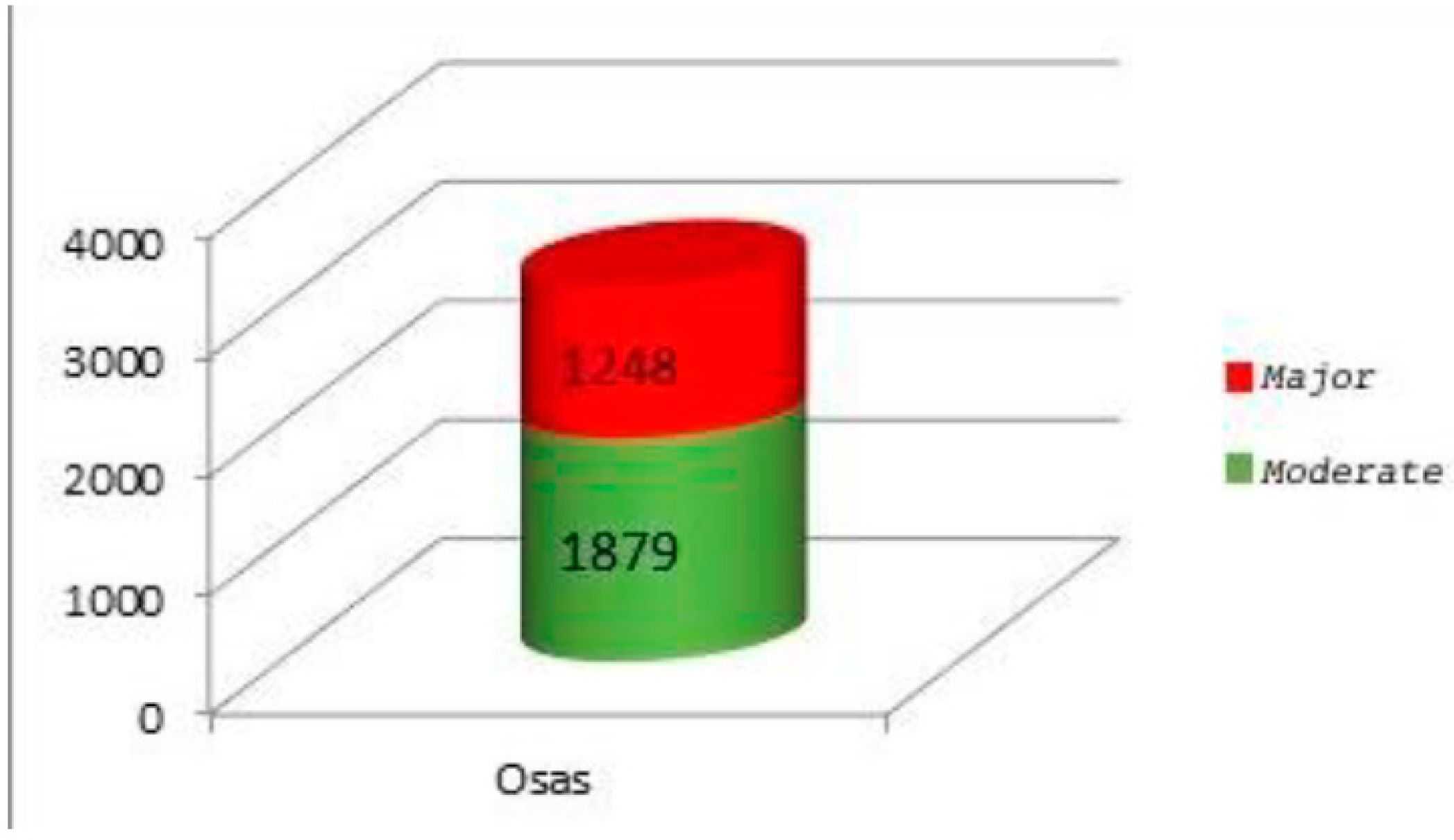

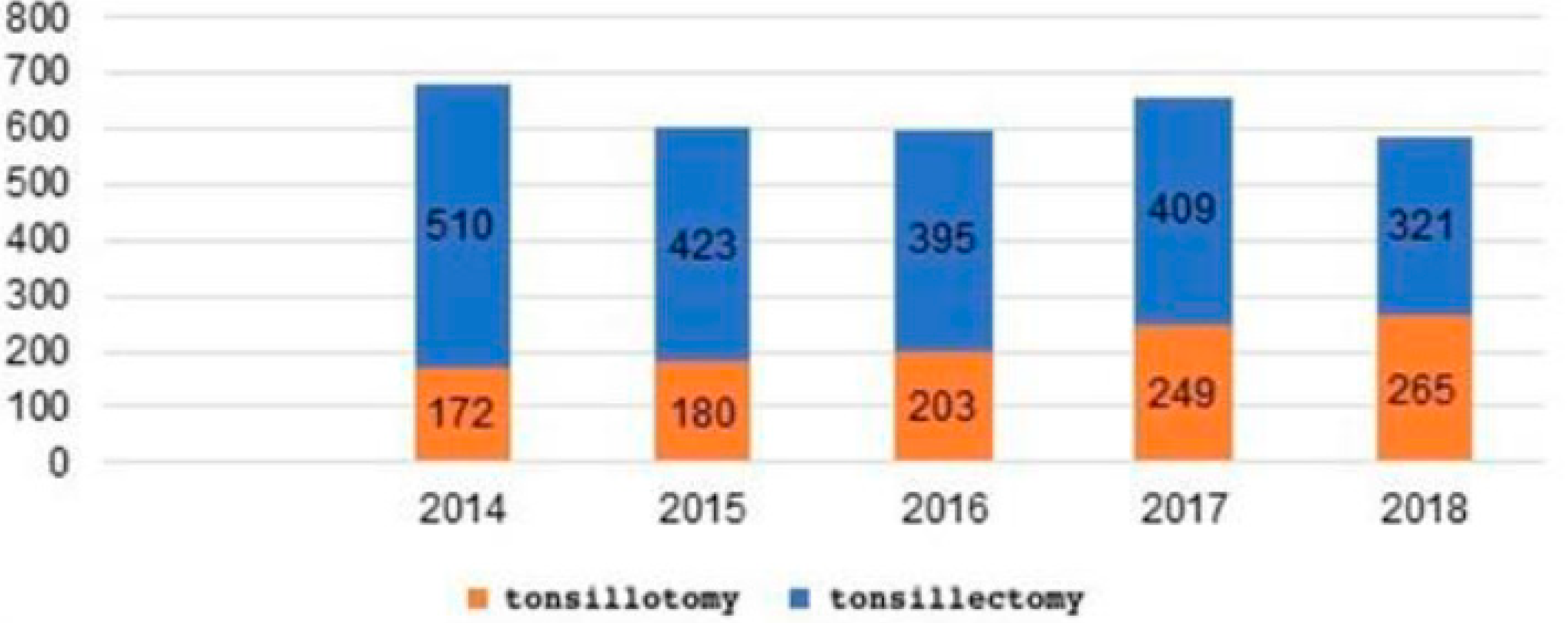
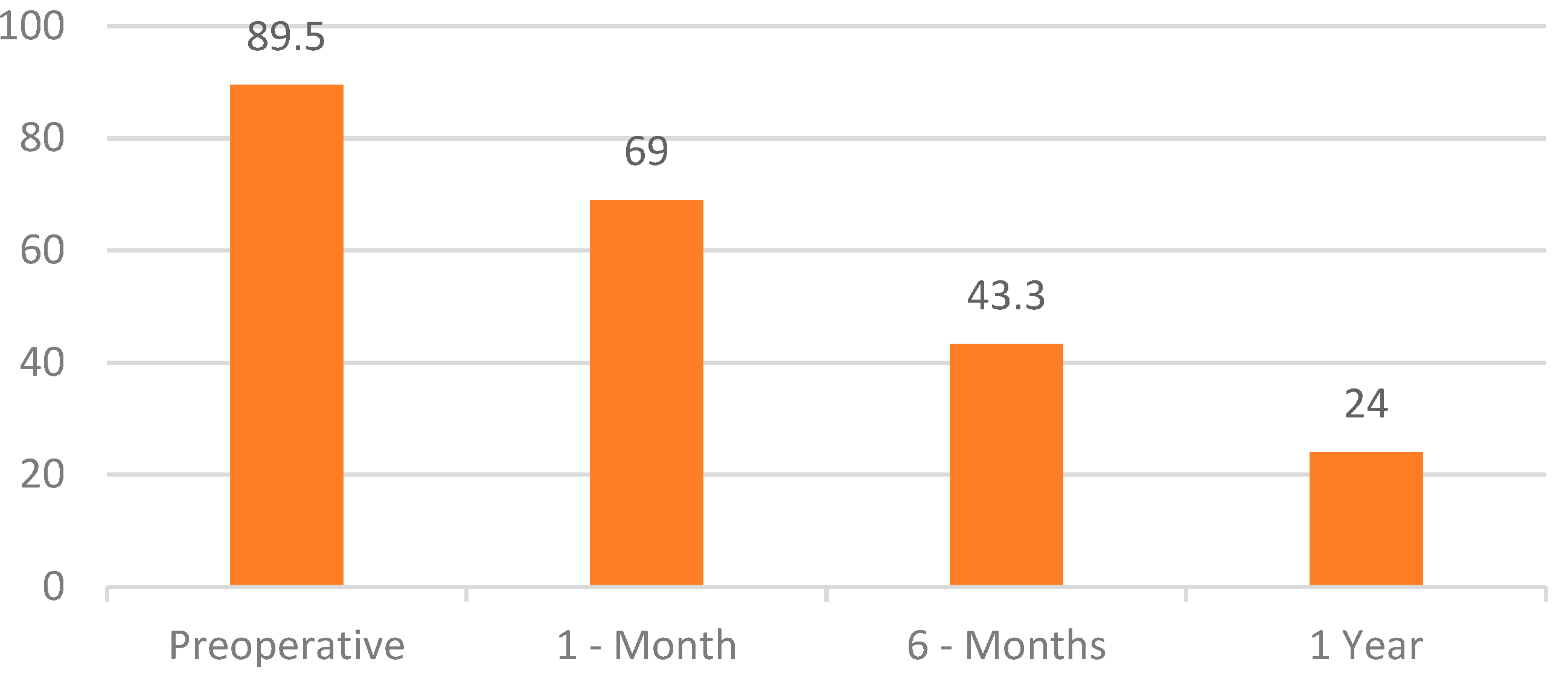
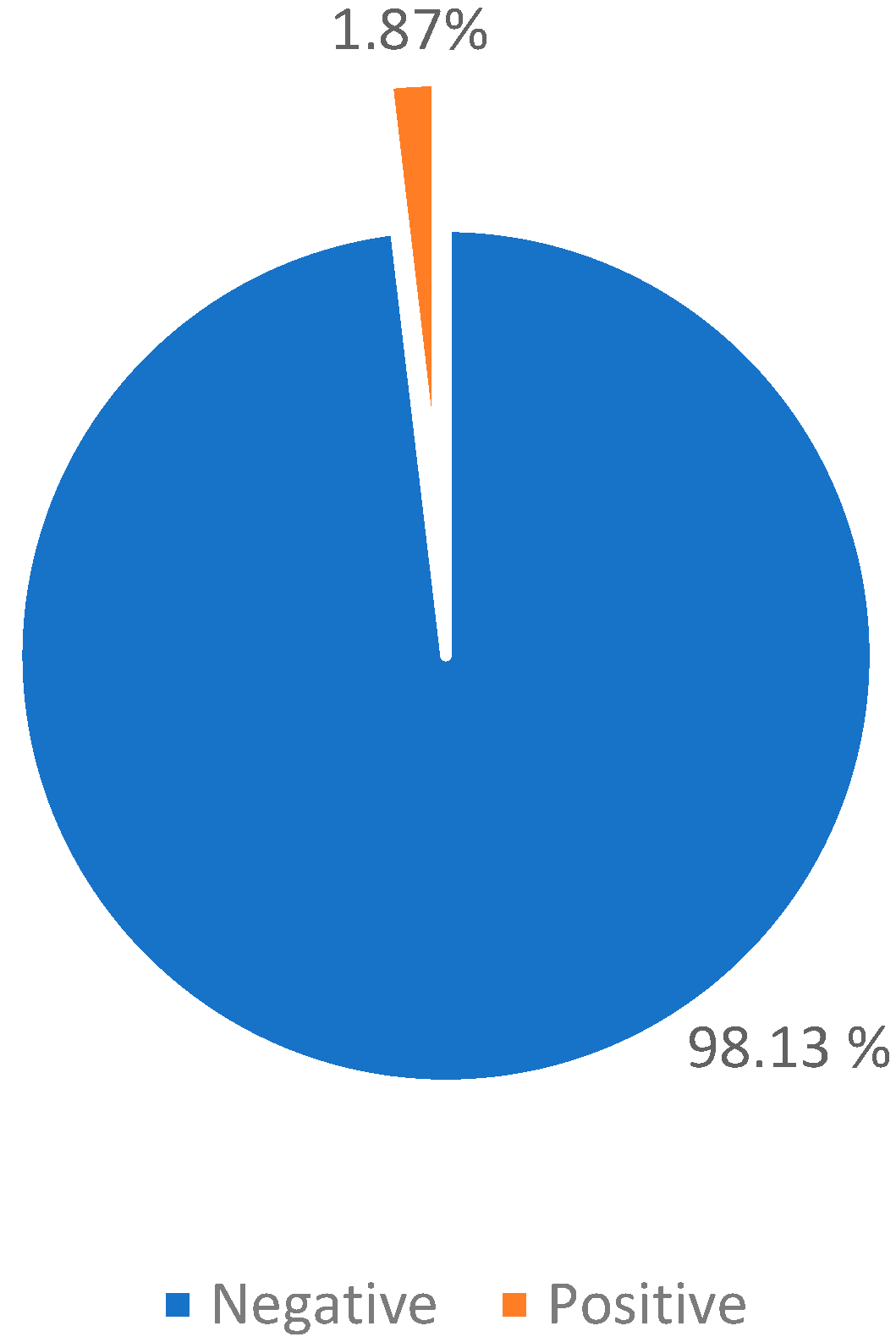
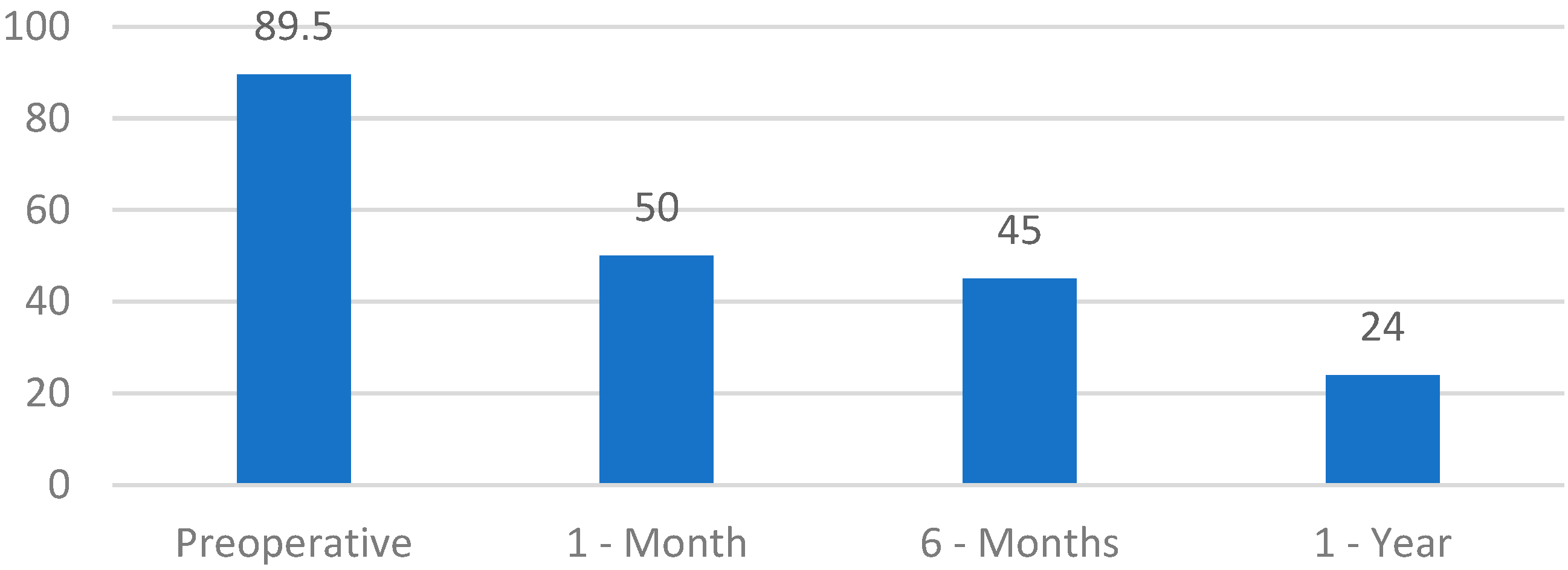

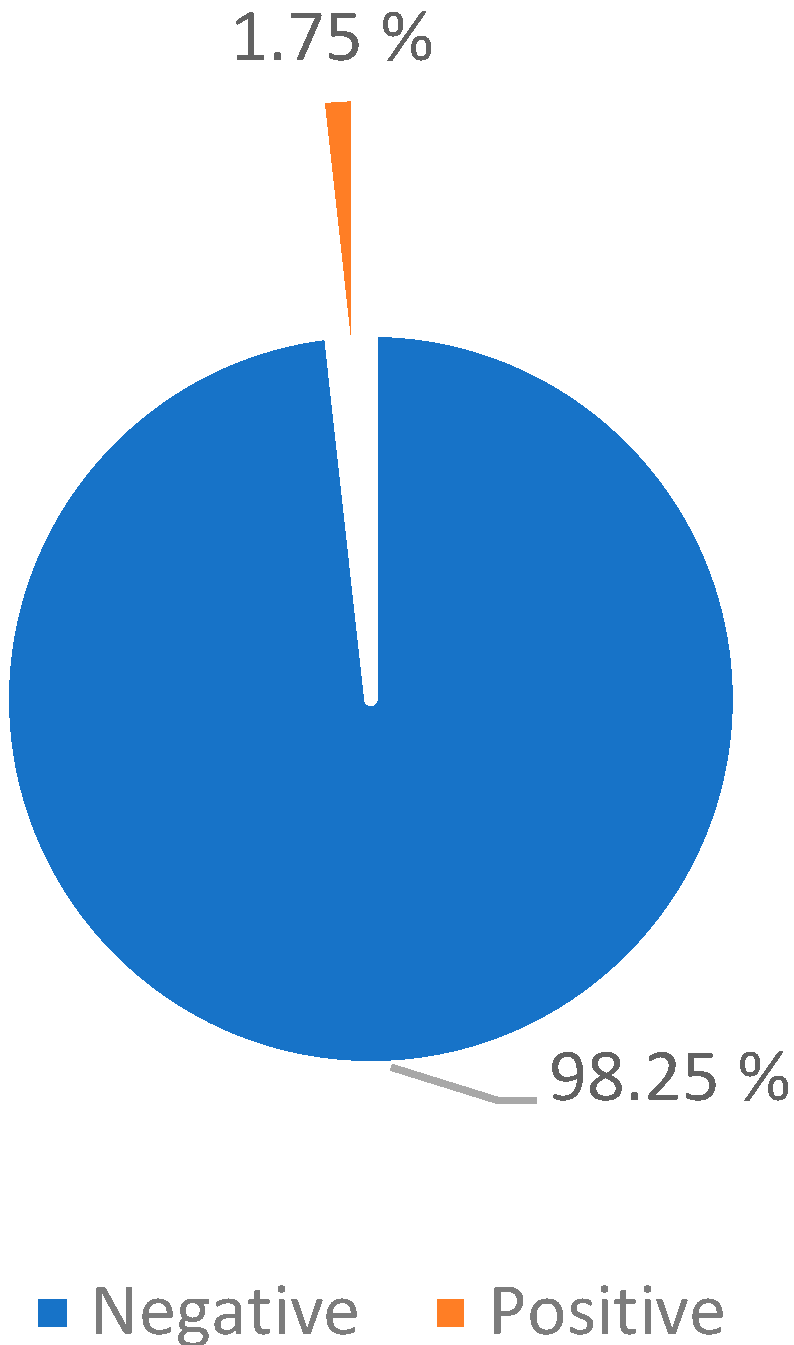
| Sample 5000 Patients | |
|---|---|
| 3127 patients (62.54%) with: | 1873 patients (37.46%) with: |
| 3st–4nd degree adenotonsillar hypertrophy | 1st–2nd degree adenotonsillar hypertrophy |
| OSA-18 survey score > 60 | OSA-18 survey score > 60 |
| Average Age (Years) | 5.21 |
| St. Dev. | ±2.29 |
| % Males | 59% |
| % Females | 41% |
| Total Surgeries | Group A | % | Group B | % | |
|---|---|---|---|---|---|
| 2014 | 682 | 172 | 25% | 510 | 75% |
| 2015 | 603 | 180 | 30% | 423 | 70% |
| 2016 | 598 | 203 | 34% | 395 | 66% |
| 2017 | 658 | 249 | 38% | 409 | 62% |
| 2018 | 586 | 265 | 45% | 321 | 55% |
| Total | 3127 | 1069 | 34% | 2058 | 66% |
| Group A | Group B | |
|---|---|---|
| Wong-Baker Scale | 79.99% (2) 20.21% (3) | 79.88% (5) 20.02% (4) |
| Days of paracetamol administering | 2 days | 4 days |
| Hospitalization | 1 night | 1 night |
| Return to solid diet | 6 days | 10 days |
| Return to daily activities | 7 days | 10 days |
| Total | Group A | % 1 | Group B | % 1 | |
|---|---|---|---|---|---|
| Number of surgeries | 3127 | 1069 | 34.19% | 2058 | 65.80% |
| Number of post-operative bleedings | 50 | 5 | 0.16% | 45 | 1.44% |
| Preoperative | 1 Month Follow-up | 6 Months Follow-up | 1 Year Follow-up | |
|---|---|---|---|---|
| Rinopharynx endoscopy | 100% of patients presented 3rd–4th degree adenotonsillar hyperplasia | Tonsillar lymphoid tissue residuals; Absence of adenoid lymphatic tissue | Clinical stability | Clinical stability |
| OSA-18 | Average value 89.5 | Average value 69.0 | Average value 43.3 | Average value 24.0 |
| Pulse oximetry | Positive in 1069 patients (100%) | Negative in 1049 patients (98.13%) Positive in 20 patients (1.87%) | 45 |
| Peoperartive | Postoperative | |
|---|---|---|
| Positive pulse oximetry | 1069 patients | 20 patients |
| % positive yielding pulse oximetry | 100% | 1.87% |
| Preoperative | 1 Month Follow-up | 6 Months Follow-up | 1 Year Follow-up | |
|---|---|---|---|---|
| Rinopharynx endoscopy | 3rd–4th degree adenotonsillar hyperplasia in 100% of the patients | Adenoid and tonsillar lymphoid tissue absence | Clinical stability | Clinical stability |
| OSA-18 | Average value 89.5 | Average value 50.0 | Average value 46.7 | Average value 27.5 |
| Pulse oximetry | Positive in 2058 patients (100%) | Negative in 2022 patients (98.25%) Positive in 36 patients (1.75%) | 45 |
| Peoperartive | Postoperative | |
|---|---|---|
| Positive pulse oximetry | 2058 patients | 36 patients |
| % positive yielding pulse oximetry | 100% | 1.75% |
| Total | % 1 | Tonsillotomy (Group A) | % 1 | Tonsillectomy (Group B) | ||
|---|---|---|---|---|---|---|
| Total surgeries | 3127 | 100.00% | 1069 | 34.19 | 2058 | 65.81% |
| Improved | 3071 | 98.21% | 1049 | 33.55% | 2022 | 64.66% |
| Worsened | 56 | 1.79% | 20 | 0.64% | 36 | 1.15% |
| Total | Tonsillotomy | % 1 | Tonsillectomy | % 1 | |
|---|---|---|---|---|---|
| Surgeries | 3127 | 1069 | 34.19% | 2058 | 65.81% |
| Postoperative failures | 56 | 20 | 0.64% | 36 | 1.15% |
Disclaimer/Publisher’s Note: The statements, opinions and data contained in all publications are solely those of the individual author(s) and contributor(s) and not of MDPI and/or the editor(s). MDPI and/or the editor(s) disclaim responsibility for any injury to people or property resulting from any ideas, methods, instructions or products referred to in the content. |
© 2023 by the authors. Licensee MDPI, Basel, Switzerland. This article is an open access article distributed under the terms and conditions of the Creative Commons Attribution (CC BY) license (https://creativecommons.org/licenses/by/4.0/).
Share and Cite
Mesolella, M.; Allosso, S.; Coronella, V.; Massimilla, E.A.; Mansi, N.; Motta, G.; Salerno, G.; Motta, G. Extracapsular Tonsillectomy versus Intracapsular Tonsillotomy in Paediatric Patients with OSAS. J. Pers. Med. 2023, 13, 806. https://doi.org/10.3390/jpm13050806
Mesolella M, Allosso S, Coronella V, Massimilla EA, Mansi N, Motta G, Salerno G, Motta G. Extracapsular Tonsillectomy versus Intracapsular Tonsillotomy in Paediatric Patients with OSAS. Journal of Personalized Medicine. 2023; 13(5):806. https://doi.org/10.3390/jpm13050806
Chicago/Turabian StyleMesolella, Massimo, Salvatore Allosso, Valentina Coronella, Eva Aurora Massimilla, Nicola Mansi, Giovanni Motta, Grazia Salerno, and Gaetano Motta. 2023. "Extracapsular Tonsillectomy versus Intracapsular Tonsillotomy in Paediatric Patients with OSAS" Journal of Personalized Medicine 13, no. 5: 806. https://doi.org/10.3390/jpm13050806
APA StyleMesolella, M., Allosso, S., Coronella, V., Massimilla, E. A., Mansi, N., Motta, G., Salerno, G., & Motta, G. (2023). Extracapsular Tonsillectomy versus Intracapsular Tonsillotomy in Paediatric Patients with OSAS. Journal of Personalized Medicine, 13(5), 806. https://doi.org/10.3390/jpm13050806








